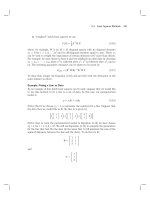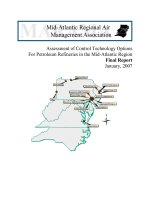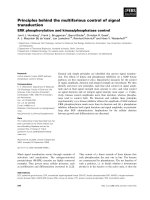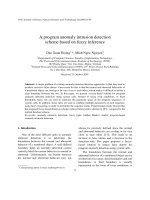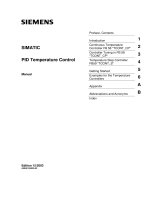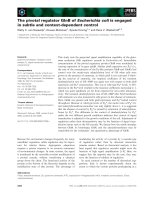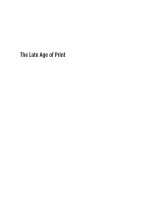Fuzzy Control potx
Bạn đang xem bản rút gọn của tài liệu. Xem và tải ngay bản đầy đủ của tài liệu tại đây (5.18 MB, 522 trang )
Fuzzy Control
Kevin M. Passino
Department of Electrical Engineering
The Ohio State University
Stephen Yurkovich
Department of Electrical Engineering
The Ohio State University
An Imprint of Addison-Wesley Longman, Inc.
Menlo Park, California
•
Reading, Massachusetts
•
Harlow, England
•
Berkeley, California
Don Mills, Ontaria
•
Sydney
•
Bonn
•
Amsterdam
•
Mexico City
ii
Assistant Editor: Laura Cheu
Editorial A ssistant: Royden Tonomura
Senior Production Editor: Teri Hyde
Marketing Manager: Rob Merino
Manufacturing Supervisor: Janet Weaver
Art and Design Manager: Kevin Berry
Cover Design: Yvo Riezebos (technical drawing by K. Passino)
Text Design: Peter Vacek
Desig n Macro Writer: William Erik B axter
Copyeditor: Brian Jones
Proofreader: Holly McLean-Aldis
Copyright
c
1998 Addison Wesley Longman, Inc.
All rights reserved. No part of this publicationmaybereproduced, or stored in a database
or retrieval system, or transmitted, in any form or by any means, electronic, mechanical,
photocopying, recording, or otherwise, without the prior written permission of the pub-
lisher. Printed in the United States of America. Printed simultaneously in Canada.
Many of the designations used by manufacturers and sellers to distinguish their products
are claimed as trademarks. Where those designations appear in this book, and Addison-
Wesley was aware of a trademark claim, the designations have been printed in initial caps
or in all caps.
MATLAB is a registered trademark of The MathWorks, Inc.
Library of Congres s Cataloging-in-Publication Data
Passino, Kevin M.
Fuzzy control / Kevin M. Passino and Stephen Yurkovich.
p. cm.
Includes bibliographical references and index.
ISBN 0-201-18074-X
1. Automatic control. 2. Control theory. 3. Fuzzy systems.
I. Yurkovich, Stephen. II. Title.
TJ213.P317 1997 97-14003
629.8’9 DC21 CIP
Instructional Material Disclaimer: The programs presented in this book have been
included for their instructional value. They have been tested with care but are not guaran-
teed for any particular purpose. Neither the publisher or the authors offer any warranties
or representations, nordotheyaccept any liabilities with respect to the programs.
About the Cover: An explanation of the technical drawing is given in Chapter 2 on
page 50.
ISBN 0–201–18074–X
12345678910—CRW—0100999897
iii
Addison Wesley Longman, Inc., 2725 Sand Hill Road, Menlo Park, California 94025
iv
To Annie and Juliana (K.M.P)
To Tricia, B.J., and James (S.Y.)
v
vi
Preface
Fuzzy control is a practical alternative for a variety of challenging control applica-
tions since it provides a convenient method for constructing nonlinear controllers
via the use of heuristic information. Suchheuristic information may come from
an operator who has acted as a “human-in-the-loop” controller for a process. In
the fuzzy control design methodology, we ask this operator to write down a set of
rules on how to control the process, then we incorporate these into a fuzzy con-
troller that emulates the decision-making process of the human. In other cases, the
heuristic information may come from a control engineer who has performed exten-
sive mathematical modeling, analysis, and development of control algorithms for a
particular process. Again, such expertiseisloaded into the fuzzy controller to au-
tomate the reasoning processes and actions of the expert. Regardless of where the
heuristic control knowledge comes from, fuzzy control provides a user-friendly for-
malism for representing and implementing the ideas we have about how to achieve
high-performance control.
In this book we provide a control-engineering perspective on fuzzy control.
We are concerned with both the construction of nonlinear controllers for challeng-
ingreal-world applications and with gaining a fundamental understanding of the
dynamics of fuzzy control systems so that we can mathematically verify their prop-
erties (e.g., stability) before implementation. We emphasize engineering evaluations
of performance and comparative analysis with conventional control methods. We
introduce adaptive methods for identification, estimation, and control. We exam-
ine numerous examples, applications, and design and implementation case studies
throughout the text. Moreover, we provide introductions to neural networks, ge-
neticalgorithms, expert and planning systems, and intelligent autonomous control,
and explain how these topics relate to fuzzy control.
Overall, we take a pragmatic engineering approach tothedesign, analysis,
performance evaluation, and implementation of fuzzy control systems. We are not
concernedwith whether the fuzzy controller is “artificially intelligent” or with in-
vestigating the mathematics of fuzzy sets (although some of the exercises do), but
vii
viii
rather with whether the fuzzy control methodology can help solve challenging real-
world problems.
Overview of the Book
The book is basically broken into three parts. In Chapters 1–4 we cover the basics of
“direct” fuzzy control (i.e., the nonadaptive case). In Chapters 5–7 we cover adap-
tive fuzzy systems for estimation, identification, and control. Finally, in Chapter 8
we briefly cover the main areas of intelligent control and highlight how the topics
covered in this book relate to these areas. Overall, we largely focus on what one
could call the “heuristic approach to fuzzy control” as opposed to the more recent
mathematical focus on fuzzy control where stability analysis is a major theme.
In Chapter 1 we provide an overview of the general methodology for conven-
tional control system design. Then we summarize the fuzzy control system design
process and contrast the two. Next, we explain what this book is about via a simple
motivating example. In Chapter 2 we first provide a tutorial introduction to fuzzy
control via a two-input, one-output fuzzy control design example. Following this
we introduce a general mathematical characterization of fuzzy systems and study
their fundamental properties. We use a simple inverted pendulum example to illus-
trate some of the most widely used approaches to fuzzy control system design. We
explain how to write a computer program to simulate a fuzzy control system, using
either a high-levellanguage or Matlab
1
.Inthewebandftppages for the book we
provide such code in C and Matlab. In Chapter 3 we use several case studies to
show how to design, simulate, and implement a variety of fuzzy control systems.
In these case studies we pay particular attention to comparative analysis with con-
ventional approaches. In Chapter 4 we show how to perform stability analysis of
fuzzy control systems using Lyapunov methods and frequency domain–based sta-
bility criteria. We introduce nonlinear analysis methods that can be used to predict
and eliminate steady-state tracking error and limit cycles. We then show how to
use the analysis approaches in fuzzy control system design. The overall focus for
these nonlinear analysis methods is on understanding fundamental problems that
can be encountered in the design of fuzzy control systems and how to avoid them.
In Chapter 5 we introduce the basic “function approximation problem” and
show how identification, estimation, prediction, and some control design problems
are a special case of it. We show how to incorporate heuristic information into the
function approximator. We show how to form rules for fuzzy systems from data pairs
andshow how to train fuzzy systems from input-output data with least squares,
gradient, and clustering methods. And we show how one clustering method from
fuzzy pattern recognition can be used in conjunction with least squares methods to
construct a fuzzy model from input-output data. Moreover, we discuss hybrid ap-
proaches that involve acombination of two or more of these methods. In Chapter 6
we introduce adaptive fuzzy control. First, we introduce several methods for auto-
matically synthesizing and tuning a fuzzy controller, and then we illustrate their
application via several design and implementation case studies. We also show how
1. MATLAB is a registered trademark of The MathWorks, Inc.
ix
to tune a fuzzy model of the plant and use the parameters of such a model in the
on-line design of a controller. In Chapter 7 we introduce fuzzy supervisory control.
We explain how fuzzy systems can be used to automatically tune proportional-
integral-derivative (PID) controllers,howfuzzy systems provide a methodology
for constructing and implementing gain schedulers, and how fuzzy systems can be
used to coordinate the application and tuning of conventional controllers. Follow-
ing this, we show how fuzzy systems can be used to tune direct and adaptive fuzzy
controllers. We provide case studies in the design and implementation of fuzzy
supervisorycontrol.
In Chapter 8 we summarize our control engineeringperspective on fuzzy control,
provide an overview of the other areas of the field of “intelligent control,” and
explain how these other areas relate to fuzzy control. In particular, we briefly cover
neural networks, genetic algorithms, knowledge-based control (expert systems and
planning systems),and hierarchical intelligent autonomous control.
Examples, Applications, and Design and Implementation Case Studies
We provide several design and implementation case studies for a variety of appli-
cations, and many examples are used throughout the text. The basic goals of these
case studies and examples are as follows:
•
To help illustrate the theory.
•
To show how toapply the techniques.
•
To help illustrate design procedures in a concrete way.
•
To show what practical issues are encountered in the development and implemen-
tation of a fuzzy control system.
Some of the more detailed applications that are studied in the chapters and their
accompanying homework problems are the following:
•
Direct fuzzy control: Translational inverted pendulum, fuzzy decision-making sys-
tems, two-link flexible robot, rotational inverted pendulum, and machine schedul-
ing(Chapters 2 and 3 homework problems: translational inverted pendulum, au-
tomobile cruise control, magnetic ball suspension system, automated highway sys-
tem, single-link flexible robot, rotational inverted pendulum, machine scheduling,
motor control, cargo ship steering, base braking control system, rocket velocity
control, acrobot, and fuzzy decision-making systems).
•
Nonlinear analysis: Inverted pendulum, temperature control, hydrofoil controller,
underwater vehicle control, and tape drive servo (Chapter 4 homework problems:
inverted pendulum, magnetic ball suspension system, temperature control, and
hydrofoil controller design).
x
•
Fuzzy identification and estimation: Engine intake manifold failure estimation,
and failure detection and identification for internal combustion engine calibra-
tion faults (Chapter 5 homework problems: tank identification, engine friction
estimation, and cargo ship failures estimation).
•
Adaptive fuzzy control: Two-link flexible robot, cargo ship steering, fault toler-
antaircraftcontrol, magnetically levitated ball, rotational inverted pendulum,
machine scheduling, and level control in a tank (Chapter 6 homework problems:
tanker and cargo ship steering, liquid level control in a tank, rocket velocity con-
trol, base braking control system, magnetic ball suspension system, rotational
inverted pendulum, and machine scheduling).
•
Supervisory fuzzy control: Two-link flexible robot, and fault-tolerant aircraft con-
trol (Chapter 7 homework problems: liquidlevel control, and cargo and tanker
ship steering).
Some of the applications and examples are dedicated to illustrating one idea from
the theory or one technique. Others are used in several places throughout the text
to show how techniques build on one another and compare to each other. Many of
the applications show how fuzzy control techniques compare to conventional control
methodologies.
World Wide Web Site and FTP Site: Computer Code Available
The following information is available electronically:
•
Various versions of C and Matlab code for simulation of fuzzy controllers, fuzzy
control systems, adaptive fuzzy identification and estimation methods, and adap-
tive fuzzy control systems (e.g., for some examples and homework problems in
the text).
•
Other special notes of interest, including an errata sheet if necessary.
Youcan access this information via the web site:
/>or youcan access the information directly via anonymous ftp to
/>For anonymous ftp, log into the above machine with a username “anonymous” and
use your e-mail address as a password.
Organization, Prerequisites, and Usage
Each chapter includes an overview, a summary, and a section “For Further Study”
that explains how the reader can continue study in the topical area of the chapter.
At the end of each chapter overview, we explain how thechapter is related to the
xi
others. This includes an outline of what must be covered to be able to understand
the later chapters and what may be skipped on a first reading. The summaries at
the end of each chapter provide a list of all major topics covered in that chapter so
that it is clear what should belearned in each chapter.
Each chapter also includes a set of exercises or design problems and often both.
Exercises or design problems that are particularly challenging (considering how far
along you are in the text) or that require you to helpdefine part of the problem are
designated with astar(“”) after the title of the problem. In addition to helping
to solidify the concepts discussed in the chapters, the problems at the ends of
the chapters are sometimes used to introduce new topics. We require the use of
computer-aided design (CAD) for fuzzy controllers in many of the design problems
at the ends of the chapters (e.g., via the use of Matlab or some high-level language).
The necessary background for the book includes courses on differential equa-
tions and classical control (root locus, Bode plots, Nyquist theory, lead-lag com-
pensation, and state feedback concepts including linear quadratic regulator design).
Coursesonnonlinear stability theory and adaptive control would be helpful but
arenot necessary. Hence, much of the material can be covered in an undergraduate
course. For instance, one could easily cover Chapters 1–3 in an undergraduate course
as they require very little background besides a basic understanding of signals and
systems including Laplace and z-transform theory (one application in Chapter 3
does, however, require a cursory knowledge of the linear quadratic regulator). Also,
many parts of Chapters 5–7 can be covered once a student has taken a first course
in control (a course in nonlinear control would be helpful for Chapter 4 but is not
necessary). One could cover the basics of fuzzy control by adding parts of Chapter 2
to the end of a standard undergraduate or graduate course on control. Basically,
however, we view the book as appropriate for a first-level graduate course in fuzzy
control.
We have used the book for aportion (six weeks) of a graduate-level course on
intelligent control and for undergraduate independent studies and design projects.
In addition, portions of the text have been used for short courses and workshops on
fuzzy control where the focus has been directed at practicing engineers in industry.
Alternatively, the text could be used for a course on intelligent control. In this
case, the instructor could cover the material in Chapter 8 on neural networks and
genetic algorithms after Chapter 2 or 3, then explain their role in the topics covered
in Chapters 5, 6, and 7 while these chapters are covered. For instance, in Chapter 5
the instructor would explain how gradient and least squares methods can be used
to train neural networks. In Chapter 6 theinstructor could draw analogies between
neural control via the radial basis function neural network and the fuzzy model
reference learning controller. Also, for indirect adaptive control, the instructor could
explain how, for instance, the multilayer perceptron or radial basis function neural
networks can be used as the nonlinearity that is trained to act like the plant. In
Chapter 7 the instructor could explain how neural networks can be trained to serve
as gain schedulers. After Chapter 7 the instructor could then cover the material on
expert control, planning systems, and intelligent autonomous control in Chapter 8.
Many more details on strategies for teaching the material in a fuzzy or intelligent
xii
control course are given in the instructor’s manual, which is described below.
Engineers and scientists working in industry will find that the book will serve
nicely as a “handbook” for the development of fuzzy control systems, and that the
design, simulation, and implementation case studies will provide very good insights
into how to construct fuzzy controllers for specific applications. Researchers in
academia and elsewhere will find that this book will provide an up-to-date view
of the field, show the major approaches, provide good references for further study,
and provide a nice outlook for thinking about future research directions.
Instructor’s Manual
An Instructor’s Manual to accompany this textbook is available (to instructors only)
from Addison Wesley Longman. The Instructor’s Manual contains the following:
•
Strategies forteachingthematerial.
•
Solutions to end-of-chapter exercises and design problems.
•
Adescription of a laboratory course that has been taught several times at The
Ohio State University which can be run in parallel with a lecture course that is
taught out of this book.
•
An electronic appendix containing the computer code (e.g., C and Matlab code)
for solving many exercises and design problems.
Sales Specialists at Addison Wesley Longman will make the instructor’s manual
available to qualified instructors. To find out who your Addison Wesley Longman
Sales Specialist is please see the web site:
/>or send an email to:
Feedback on the Book
It is our hope that we will get the opportunity to correct any errors in this book;
hence, we encourage you to provide a precise description of any errors you may
find. We are also open to your suggestions on how to improve the textbook. For
this, please use either e-mail () or regular mail to the
first author: Kevin M. Passino, Dept. of Electrical Engineering, The Ohio State
University, 2015 Neil Ave., Columbus, OH 43210-1272.
Acknowledgments
No book is written in a vacuum, and this is especially true for this one. We must
emphasize that portions of the book appeared in earlier forms as conference pa-
pers, journal papers, theses, or project reports with our students here at Ohio
xiii
State. Due to this fact, these parts of the text are sometimes a combination of our
words and those of our students (which are very difficult to separate at times).
In every case where we use such material, the individuals have given us permis-
sion to use it, and we provide the reader with a reference to the original source
since this will typically provide more details than what are covered here. While
we always make it clear where the material istakenfrom, it is our pleasure to
highlight these students’ contributions here as well. In particular, we drew heavily
from work with the following students and papers written with them (in alpha-
betical order): Anthony Angsana [4], Scott C. Brown [27], David L. Jenkins [83],
Waihon Andrew Kwong [103, 104, 144], Eric G. Laukonen [107, 104], Jeffrey R.
Layne[110, 113, 112, 114, 111], William K. Lennon [118], Sashonda R. Morris
[143], Vivek G. Moudgal [145, 144], Jeffrey T. Spooner [200, 196], and Moeljono
Widjaja [235, 244]. These students, and Mehmet Akar, Mustafa K. Guven, Min-
Hsiung Hung, Brian Klinehoffer, Duane Marhefka, Matt Moore, Hazem Nounou,
Jeff Palte, and Jerry Troyer helped by providing solutions to several of the exer-
cises and design problems and these are contained in the instructor’s manual for this
book. Manfredi Maggiore helped by proofreading the manuscript. Scott C. Brown
and Ra´ul Ord´o˜nez assisted in the development of the associated laboratory course
at OSU.
We would like to gratefully acknowledge the following publishers for giving us
permission to use figures that appeared in some of our past publications: The In-
stitute of Electrical and Electronic Engineers (IEEE), John Wiley and Sons, Hemi-
sphere Publishing Corp., and Kluwer Academic Publishers. In each case where we
use a figure from a past publication, we give the full reference to the original pa-
per, and indicate in the caption of the figure that the copyright belongs to the
appropriate publisher (via, e.g., “
c
IEEE”).
We have benefited from many technical discussions with many colleagues who
work in conventional and intelligent control (too many to list here); most of these
persons are mentioned by referencing their work in the bibliography at the end of
the book. We would, however, especially like to thank Zhiqiang Gao and Oscar R.
Gonz´alez for class-testing this book. Moreover, thanks go to the following persons
who reviewed various earlier versions of the manuscript: D. Aaronson, M.A. Abidi,
S.P. Colombano, Z. Gao, O. Gonz´alez, A.S. Hodel, R. Langari, M.S. Stachowicz,
and G. Vachtsevanos.
We would like to acknowledge the financial support of National Science Foun-
dation grants IRI-9210332 and EEC-9315257, the second of which was for the de-
velopment of a course and laboratory for intelligent control. Moreover, we had
additional financial support from a variety of other sponsors during the course of
the development of this textbook, some of whom gave us the opportunity to apply
some of the methods in this text to challenging real-world applications, and others
where one or both of us gave a course on the topics covered in this book. These
sponsors include Air Products and Chemicals Inc., Amoco Research Center, Bat-
telle Memorial Institute, Delphi Chassis Division of General Motors, Ford Motor
Company, General Electric Aircraft Engines, The Center for Automotive Research
(CAR)atThe Ohio State University, The Center for Intelligent Transportation
xiv
Research (CITR) at The Ohio State University, and The Ohio Aerospace Institute
(in a teamed arrangement with Rockwell International Science Center and Wright
Laboratories).
We would like to thank Tim Cox, Laura Cheu, Royden Tonomura, Teri Hyde,
RobMerino, Janet Weaver, Kevin Berry, Yvo Riezebos, Peter Vacek, William Erik
Baxter, Brian Jones, and Holly McLean-Aldis for all their helpintheproduction
and editing of this book. Finally, we would most like to thank our wives,whohave
helped set up wonderful supportive home environments that we value immensely.
Kevin Passino
Steve Yurkovich
Columbus, Ohio
July 1997
Contents
PREFACE vii
CHAPTER 1 / Introduction 1
1.1 Overview 1
1.2 Conventional Control System Design 3
1.2.1 Mathematical Modeling 3
1.2.2 Performance Objectives and Design Constraints 5
1.2.3 Controller Design 7
1.2.4 Performance Evaluation 8
1.3 Fuzzy Control System Design 10
1.3.1 Modeling Issues and Performance Objectives 12
1.3.2 Fuzzy Controller Design 12
1.3.3 Performance Evaluation 13
1.3.4 Application Areas 14
1.4 What This Book IsAbout 14
1.4.1What the Techniques Are Good For: An Example 15
1.4.2 Objectives of This Book 17
1.5 Summary 18
1.6 For Further Study 19
1.7 Exercises 19
CHAPTER 2 / Fuzzy Control: The Basics 23
2.1 Overview 23
2.2Fuzzy Control: A Tut orial Introduction 24
2.2.1Choosing F uzzy Controller Inputs and Outputs 26
2.2.2 Putting Control Knowledge into Rule-Bases 27
xv
xvi CONTENTS
2.2.3 Fuzzy Quantification of Knowledge 32
2.2.4 Matching: Determining Which Rules to Use 37
2.2.5Inference Step: Determining Conclusions 42
2.2.6 Converting Decisions into Actions 44
2.2.7 Graphical Depiction of Fuzzy Decision Making 49
2.2.8 Visualizing the Fuzzy Controller’s Dynamical Operation 50
2.3General Fuzzy S ystems 51
2.3.1 Linguistic Variables, V alues, and Rules 52
2.3.2 Fuzzy Sets, Fuzzy Logic, and the Rule-Base 55
2.3.3 Fuzzification 61
2.3.4The Inference Mechanism 62
2.3.5 Defuzzification 65
2.3.6 Mathematical Representations of Fuz zy Systems 69
2.3.7 Takagi-Sugeno Fuzzy Systems 73
2.3.8 Fuzzy Systems Are U niversal Approximators 77
2.4Simple Design Example: The Inverted Pendulum 77
2.4.1 Tuning via Scaling Universes of Discourse 78
2.4.2Tuning Membership Functions 83
2.4.3 The Nonlinear S urface for the Fuzzy Controller 87
2.4.4 Summary: Basic Design Guidelines 89
2.5 Simulation of Fuzzy Control Systems 91
2.5.1 Simulation of Nonlinear Systems 91
2.5.2 Fuzzy Controller Arrays and Subroutines 94
2.5.3Fuzzy Controller Pseudocode 95
2.6 Real-Time Implementation Issues 97
2.6.1 Computation Time 97
2.6.2Memory Requirements 98
2.7 Summary 99
2.8 For Further Study 101
2.9 Exercises 101
2.10 Design P roblems 110
CHAPTER 3 / Case Studies in Design and Implementation 119
3.1 Overview 119
3.2 DesignMethodology 122
3.3 Vibration Damping for a Flexible Robot 124
3.3.1 The Two-Link Flexible Robot 125
3.3.2 Uncoupled Direct Fuzzy Control 129
3.3.3 Coupled Direct Fuzzy Control 134
3.4Balancing a Rotational Inverted Pendulum 142
3.4.1The Rotational Inverted Pendulum 142
CONTENTS xvii
3.4.2 A Conventional Approach to Balancing Control 144
3.4.3 Fuzzy ControlforBalancing 145
3.5Machine Scheduling 152
3.5.1Conventional Scheduling Policies 153
3.5.2Fuzzy Scheduler for a Single Machine 156
3.5.3Fuzzy Versus Conventional Schedulers 158
3.6 Fuzzy Decision-Making Systems 161
3.6.1 Infectious Disease Wa rning System 162
3.6.2 Failure Warning System for an Airc raft 166
3.7 Summary 168
3.8 For Further Study 169
3.9 Exercises 170
3.10 Design P roblems 172
CHAPTER 4 / Nonlinear Analysis 187
4.1 Overview 187
4.2 Parameterized Fuzzy Controllers 189
4.2.1 Proportional Fuzzy Controller 190
4.2.2 Proportional-Derivative Fuzzy Controller 191
4.3Lyapunov Stability Analysis 193
4.3.1 Mathematical P reliminaries 193
4.3.2Lyapunov’s Direct Method 195
4.3.3Lyapunov’s Indirect Method 196
4.3.4Example:Inverted Pendulum 197
4.3.5 Example: The Parallel Distributed Compensator 200
4.4 Absolute Stability and the Circle Criterion 204
4.4.1 Analysis of Absolute Stability 204
4.4.2 Example: Temperature Control 208
4.5 Analysis of Steady-State Tracking Error 210
4.5.1 Theory of Tracking ErrorforNonlinea r S ystems 211
4.5.2 Example: Hydrofoil Controller Design 213
4.6Describing Function Analysis 214
4.6.1Predicting the Existence and Stability of Limit Cycles 214
4.6.2SISOExample:Underw ater Vehicle Control System 218
4.6.3 MISO Example: Tape Drive Servo 219
4.7 Limitations of the Theory 220
4.8 Summary 222
4.9 For Further Study 223
4.10 Exercises 225
xviii CONTENTS
4.11 Design P roblems 228
CHAPTER 5 / Fuzzy Identification and Estimation 233
5.1 Overview 233
5.2Fitting Functions to Data 235
5.2.1The Function Approximation Problem 235
5.2.2Relation to Identification, Estimation, and Prediction 238
5.2.3 Choosing the Data Set 240
5.2.4 Incorporating Linguistic Information 241
5.2.5 Case Study: E ngine Failure Data Sets 243
5.3 Least Squares Methods 248
5.3.1 Batch Least Squares 248
5.3.2Recursive Least Squares 252
5.3.3 Tuning Fuzzy Systems 255
5.3.4 Example: Batch Lea st S qua res Training of Fuzzy Systems 257
5.3.5Example:Recursive Least Squares Training of Fuzzy Systems 259
5.4 Gradient Methods 260
5.4.1 Training Standard Fuzzy Systems 260
5.4.2 Implementation Issues and Example 264
5.4.3 Training Takagi-Sugeno Fuzzy Systems 266
5.4.4 Momentum Term and Step Size 269
5.4.5 Newton and Gauss-Newton Methods 270
5.5 ClusteringMethods 273
5.5.1Clustering with Optimal Output Predefuzzification 274
5.5.2 Nearest Neighborhood Clustering 279
5.6 Extracting Rules from Data 282
5.6.1 Learning from Examples (LFE) 282
5.6.2 Modified Learning from Examples (MLFE) 285
5.7 Hybrid Methods 291
5.8 Case Study: FDI for an Engine 292
5.8.1 Experimental Engine and Testing Conditions 293
5.8.2 Fuzzy Estimator C onstruction and Results 294
5.8.3Failure Detection and Identification (FDI) Strategy 297
5.9 Summary 301
5.10 For Further Study 302
5.11 Exercises 303
5.12 Design P roblems 311
CONTENTS xix
CHAPTER 6 / Adaptive Fuzzy Control 317
6.1 Overview 317
6.2Fuzzy Model Reference Learning Control (FMRLC) 319
6.2.1 The Fuzzy Controller 320
6.2.2The Reference Model 324
6.2.3The Learning Mechanism 325
6.2.4 Alternative Knowledge-Base Modifiers 329
6.2.5 Design Guidelines for the Fuzzy Inverse Model 330
6.3 FMRLC: Design and Implementation Case Studies 333
6.3.1 Cargo Ship Steering 333
6.3.2 Fault-Tolerant Aircraft Control 347
6.3.3 Vibration Damping for a Flexible Robot 357
6.4 Dynamically Focused Learning (DFL) 364
6.4.1 Magnetic Ball Suspension System: Motivation for DFL 365
6.4.2Auto-Tuning Mechanism 377
6.4.3Auto-Attentive Mechanism 379
6.4.4Auto-Attentive M echanism with Memory 384
6.5 DFL: Design and Implementation Case Studies 388
6.5.1Rotational Inverted Pendulum 388
6.5.2Adaptive Machine Scheduling 390
6.6 Indirect Adaptive Fuzzy Control 394
6.6.1On-Line Identification Methods 394
6.6.2Adaptive Control for Feedback Linearizable Systems 395
6.6.3 Adaptive Parallel Distributed Compensation 397
6.6.4 Example: Level Control in a Surge Tank 398
6.7 Summary 402
6.8 For Further Study 405
6.9 Exercises 406
6.10 Design P roblems 407
CHAPTER 7 / Fuzzy Supervisory Control 413
7.1 Overview 413
7.2 Supervision of Co nventional Controllers 415
7.2.1 Fuzzy Tuning of PID Controllers 415
7.2.2Fuzzy Gain Scheduling 417
7.2.3 Fuzzy Supervision of Conventional Controllers 421
7.3 Supervision of Fuzzy Controllers 422
7.3.1 Rule-Base Supervision 422
7.3.2 Case Study: Vibration Damping for a Flexible Robot 423
7.3.3 SupervisedFuzzy Learning Control 427
xx CONTENTS
7.3.4 Case Study: Fault-Tolerant Aircraft Control 429
7.4 Summary 435
7.5 For Further Study 436
7.6 Design Problems 437
CHAPTER 8 / Perspectives on Fuzzy Control 439
8.1 Overview 439
8.2 Fuzzy Versus Conventional Control 440
8.2.1 Modeling Issues and Design Methodology 440
8.2.2 Stability and Performance Analysis 442
8.2.3Implementation and General Issues 443
8.3 Neural Networks 444
8.3.1Multilayer P erceptrons 444
8.3.2RadialBasis Function Neural Networks 447
8.3.3 Relationships Between Fuzzy Systems and Neural Netw o rks 449
8.4Genetic Algorithms 451
8.4.1Genetic Algorithms: A Tutorial 451
8.4.2Genetic Algorithms for Fuzzy System Design and Tuning 458
8.5 Knowledge-Based Systems 461
8.5.1 Expert Control 461
8.5.2 Planning Systems for Control 462
8.6 Intelligent and Autonomous Control 463
8.6.1 What Is “Intelligent Control”? 464
8.6.2 Architecture and Characteristics 465
8.6.3 Autonomy 467
8.6.4 Example: I ntelligent Vehicle and Highway Systems 468
8.7 Summary 471
8.8 For Further Study 472
8.9 Exercises 472
BIBLIOGRAPHY 477
INDEX 495
CHAPTER 1
Introduction
It is not only old and early impressions
that deceive us; the charms of novelty
have the same power.
–Blaise Pascal
1.1 Overview
When confronted with a control problem for a complicated physical process, a
control engineer generally follows a relatively systematic design procedure. A simple
example of a control problem is an automobile “cruise control” that provides the
automobile with the capability of regulating its own speed at a driver-specified
set-point (e.g., 55 mph). One solution to the automotive cruise control problem
involves adding an electronic controller that can sense the speed of the vehicle via
the speedometer and actuate the throttle position so as to regulate the vehicle speed
as close as possible tothedriver-specified value (the design objective). Such speed
regulation must be accurate even if there are road grade changes, head winds, or
variations in the number of passengers or amount of cargo in the automobile.
After gaining an intuitive understanding of the plant’s dynamics and establish-
ing the design objectives, the control engineer typically solves the cruise control
problem by doing the following:
1. Developing a model of the automobile dynamics (which may model vehicle and
power train dynamics, tire and suspension dynamics, the effect of road grade
variations,etc.).
2. Using the mathematical model, or a simplified version of it, to design a con-
troller (e.g., via a linear model, develop a linear controller with techniques from
classical control).
1
2Chapter 1 / Introduction
3. Using the mathematical model of the closed-loop system and mathematical
or simulation-based analysis to study its performance (possibly leading to re-
design).
4. Implementing the controller via, for example, a microprocessor, and evaluating
theperformance of the closed-loop system (again, possibly leading to redesign).
This procedure is concluded when the engineer has demonstrated that the con-
trol objectives have been met, and the controller (the “product”) is approved for
manufacturing and distribution.
In this book we show how the fuzzy control design methodology can be used
to construct fuzzy controllers for challenging real-world applications. As opposed
to “conventional” control approaches (e.g., proportional-integral-derivative (PID),
lead-lag, and state feedback control) where the focus is on modeling and the use of
this model to construct a controller that is described by differential equations, in
fuzzy control we focus on gaining an intuitive understanding of how to best control
the process, then we load this information directly into the fuzzy controller.
For instance, in the cruise control example we may gather rules about how to
regulate the vehicle’s speed from a human driver. One simple rule that a human
driver may provide is “If speed is lower than the set-point, then press down fur-
ther on the accelerator pedal.” Other rules may depend on the rate of the speed
error increase or decrease, or may provide ways to adapt the rules when there are
significant plant parameter variations (e.g., if there is a significant increase in the
mass of the vehicle, tune the rules to press harder on the accelerator pedal). For
more challenging applications, control engineers typically have to gain a very good
understanding of the plant to specify complex rules that dictate how the controller
should react to the plant outputs and reference inputs.
Basically, while differential equations are the language of conventional control,
heuristics and “rules” about how to control the plant are the language of fuzzy
control. This is not to say that differential equations are not needed in the fuzzy
control methodology.Indeed, one of the main focuses of this book will be on how
“conventional” the fuzzy control methodology really is and how many ideas from
conventional control can be quite useful intheanalysis of this new class of control
systems.
In this chapter we first provide an overview of the standard approach to con-
structing a control system and identify a wide variety of relevant conventional con-
trol ideas and techniques (see Section 1.2). We assume that the reader has at least
some familiarity with conventional control. Our focus in this book is not only on
introducing a variety of approaches to fuzzy control but also on comparing these to
conventional control approaches to determine when fuzzy control offers advantages
over conventional methods. Hence, to fully understand this book you need to un-
derstand several ideas from conventional control (e.g., classical control, state-space
baseddesign, the linear quadratic regulator, stability analysis, feedback lineariza-
tion,adaptive control, etc.). The reader not familiar with conventional control to
this extent will still find the book quite useful. In fact, we expect to whet the
1.2 Conventional Control System Design 3
appetite of such readers so that they become interested in learning more about
conventional control. At the end of this chapter we will provide a list of books that
can serve to teach such readers about these areas.
Following our overview of conventional control, in Section 1.3 we outline a
“philosophy” of fuzzy control where we explain the design methodology for fuzzy
controllers, relate this to the conventional control design methodology, and highlight
the importance of analysis and verification of the behavior of closed-loop fuzzy
control systems.
We highly recommend that you take the time to study this chapter (even if you
already understand conventional control or even the basics of fuzzy control) as it
will set the tone for the remainder of the book and provide a sound methodology
for approaching the sometimes “overhyped” field of fuzzy control. Moreover, in
Section 1.4 we provide a more detailed overviewofthisbookthanweprovided in
the Preface, and you will find this useful in deciding what topics to study closely
and which ones you may want to skip over on a first reading.
1.2 Conventional Control System Design
Abasiccontrolsystemisshown in Figure 1.1. The process (or “plant”) is the
object to be controlled. Its inputs are u(t), its outputs are y(t), and the reference
input is r(t). In the cruise control problem, u(t)isthe throttle input, y(t)isthe
speed of the vehicle, and r(t)isthedesired speed that is specified by the driver.
The plant is the vehicle itself. The controller is the computer in the vehicle that
actuates the throttle based on the speed of the vehicle and the desired speed that
was specified. In this section we provide an overview of the steps taken to design
the controller shown in Figure 1.1. Basically, these are modeling, controller design,
and performance evaluation.
T
C
P
FIGURE 1.1 Control system.
1.2.1 Mathematical Modeling
When a control engineer is given a control problem, often one of the first tasks that
sheorheundertakes is the development of a mathematical model of the process to
be controlled, in order to gain a clear understanding of the problem. Basically, there
are only a few ways to actually generate the model. We can use first principles of
4Chapter 1 / Introduction
physics (e.g., F = ma)towritedownamodel.Another way is to perform “system
identification” via the use of real plant data to produce a model of the system.
Sometimes a combined approach is used where we use physics to write down a
general differential equation that we believe represents the plant behavior, and
then we perform experiments on the plant to determine certain model parameters
or functions.
Often, more than onemathematicalmodel is produced. A “truth model” is one
that is developed to be as accurate as possible so that it can be used in simulation-
based evaluations of control systems. It must be understood, however, that there
is never aperfect mathematical modelfortheplant.Themathematical model is
an abstraction and hence cannot perfectly represent all possible dynamics of any
physical process (e.g., certain noise characteristics or failure conditions). This is
not to say that we cannot produce models that are “accurate enough” to closely
represent the behavior of a physical system. Usually, control engineers keep in mind
that for control design they only need to use a model that is accurate enough to
be able to design a controller that will work. Then, they often also need a very
accurate model to test the controller in simulation (e.g., the truth model) before
it is tested in an experimental setting. Hence, lower-order “design models” are
also often developed that may satisfy certain assumptions (e.g., linearity or the
inclusion of only certain forms of nonlinearities) yet still capture the essential plant
behavior. Indeed, it is quite an art (and science) to produce good low-order models
that satisfy these constraints. We emphasize that the reason we often need simpler
models is that the synthesis techniques for controllers often require that the model
of the plant satisfy certain assumptions (e.g., linearity) or these methods generally
cannot be used.
Linear models such as the one in Equation (1.1) have been used extensively in
the past and the control theory for linear systems is quite mature.
˙x = Ax + Bu (1.1)
y = Cx + Du
In this case u is the m-dimensional input; x is the n-dimensional state ( ˙x =
dx(t)
dt
);
y is the p dimensional output; and A, B, C,andD are matrices of appropriate
dimension. Such models, or transfer functions (G(s)=C(sI −A)
−1
B + D where
s is the Laplace variable), are appropriate for use with frequency domain design
techniques (e.g., Bode plots and Nyquist plots), the root-locus method, state-space
methods, and so on. Sometimes it is assumed that the parameters of the linear
model are constant but unknown, or can be perturbed from their nominal values
(then techniques for “robust control” oradaptive control are developed).
Much of the current focus incontrol is on the development of controllers using
nonlinear models of the plant of the form
˙x = f(x, u)(1.2)
y = g(x, u)
1.2 Conventional Control System Design 5
where the variables are defined as for the linear model and f and g are nonlinear
functionsoftheir arguments. One form of the nonlinear model that has received
significant attention is
˙x = f(x)+g(x)u (1.3)
since it is possible to exploit the structure of this model to construct nonlinear con-
trollers (e.g., in feedback linearization or nonlinear adaptive control). Of particular
interest with both of the above nonlinearmodelsisthecase where f and g are not
completely known and subsequent research focuses on robust control of nonlinear
systems.
Discrete time versions of the above models arealsoused,andstochastic effects
areoften taken into account via the addition of a random input or other stochastic
effects. Under certain assumptions you can linearize the nonlinear model in Equa-
tion (1.2) to obtain a linear one. In this case we sometimes thinkofthenonlinear
model as the truth model, and the linear models that are generated from it as con-
trol design models. We will have occasion to work with all of the above models in
this book.
There are certain properties of the plant that the control engineer often seeks
to identify early in the design process. For instance, the stability of the plant may
be analyzed (e.g., to see if certain variables remain bounded). The effects of certain
nonlinearities are also studied. The engineer may wanttodetermine if the plant
is “controllable” to see, for example, if the control inputs will be able to properly
affect the plant; and “observable” to see, for example, if the chosen sensors will allow
the controller to observe the critical plant behavior so that it can be compensated
for, or if it is “nonminimum phase.” These properties will have a fundamental
impact on our ability to design effective controllers for the system. In addition,
the engineer will try to make a general assessment of how the plant behaves under
various conditions, how the plant dynamics may change over time, and what random
effects are present. Overall, this analysis of the plant’s behavior gives the control
engineer a fundamental understanding of the plant dynamics. This will be very
valuable when it comes time to synthesize a controller.
1.2.2 Performance Objectives and Design Constraints
Controller design entails constructing a controller to meet the specifications. Often
the first issue to address is whether to useopen-orclosed-loop control. If you
can achieve your objectives with open-loop control, why turn to feedback control?
Often, you need to pay for a sensor for the feedback information and there needs
to be justification for this cost. Moreover, feedback can destabilize the system. Do
not develop a feedback controller just because you are used to developing feedback
controllers; you may want to consider an open-loop controller since it may provide
adequate performance.
Assuming you use feedback control, the closed-loop specifications (or “perfor-
mance objectives”) can involve the following factors:

